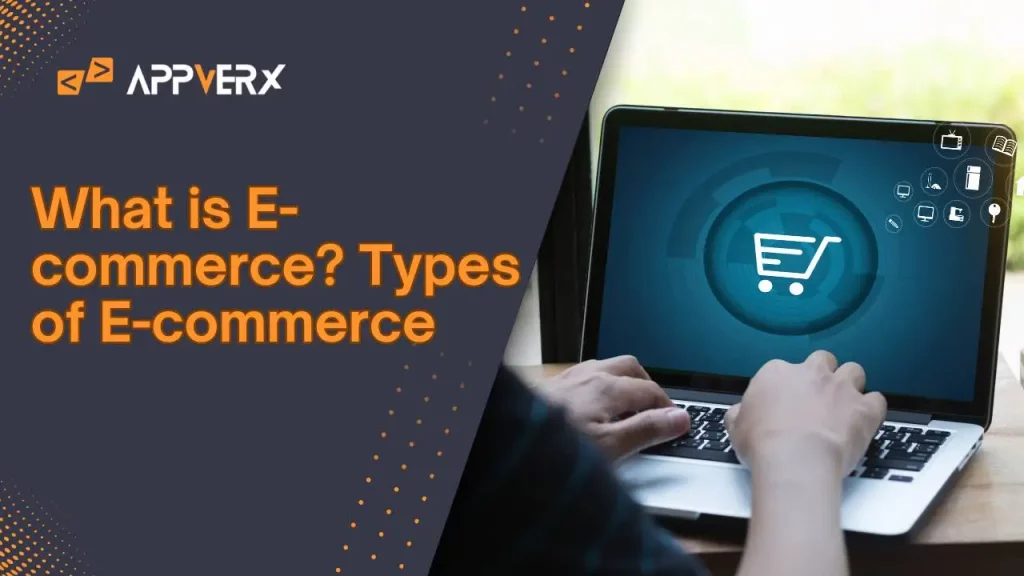What is E-commerce?
E-commerce, commonly called electronic commerce, has seamlessly woven into the fabric of our daily routines. This modern phenomenon revolves around exchanging goods and services conducted via the Internet. In simpler terms, if you’ve ever ordered something online or sold something on a platform like eBay, you’ve participated in e-commerce. Moreover, We will explore types of E-commerce in this article.
Understanding Electronic Commerce
To understand e-commerce better, let’s break it down into smaller parts. Initially, consider commerce as the exchange of goods and services through transactions. Now, add the “electronic” part, which means doing this through electronic devices like computers or smartphones connected to the Internet.
Importance of E-commerce
E-commerce holds immense significance for enterprises and customers, serving as a gateway to untapped markets and extending businesses’ outreach beyond their geographical boundaries. This digital avenue offers consumers unparalleled convenience, granting them seamless access to diverse goods and services without stepping outside their residences.
Evolution of E-commerce
The journey of e-commerce has been remarkable, evolving significantly since its inception. It started with simple online transactions but has evolved into a complex ecosystem with various models and platforms. Understanding this evolution helps us appreciate the diversity and scope of e-commerce today.
Types of E-commerce
E-commerce extends beyond a uniform solution that fits every need. There are different e-commerce models, each serving other purposes and involving various parties.
Differentiating E-commerce Models
- Business-to-consumer (B2C) E-commerce stands out as the prevalent model, enabling businesses to connect with consumers directly. Visualize renowned online marketplaces like Amazon or fashion labels managing virtual storefronts.
- Business-to-Business (B2B) E-commerce: In this model, enterprises directly vend goods or services to other businesses. It’s like when a company buys office supplies from an online vendor.
- Consumer-to-Consumer (C2C) E-commerce: Individuals sell products or services to others. Websites such as eBay and Craigslist enable and support these transactions.
- Consumer-to-business While less prevalent, consumer-to-business (C2B) E-commerce encompasses instances where consumers sell goods or services directly to businesses. For example, freelance services or user-generated content sold to companies.
- Business-to-Government (B2G) E-commerce: In this framework, enterprises engage in transactions where they offer products or services specifically to government entities. It could be anything from office equipment to software solutions.
Emerging Trends in E-commerce
Beyond the established e-commerce models, fresh currents sculpt the digital retail terrain.
- Mobile Commerce (m-commerce): The surge in smartphone usage has propelled a significant increase in mobile shopping. Convenient apps and mobile-optimized websites enable seamless browsing and purchasing while on the move.
- Social Commerce: Platforms such as Instagram and Facebook are evolving into vibrant hubs for shopping. Users can explore and acquire products directly within the app environment, eliminating the need to exit for purchases.
- Micro-commerce refers to small-scale e-commerce ventures, often run by individuals or small businesses. It could be someone selling handmade crafts on Etsy or offering online tutoring services.
Popular E-commerce Platforms
E-commerce platforms are essential for businesses establishing and overseeing their digital storefronts. Many options exist in the market, each boasting distinct attributes and functionalities tailored to meet diverse business needs.
Key Players in E-commerce:
- Shopify: Renowned for its intuitive interface and adaptable templates, Shopify stands out as a preferred choice among e-commerce platforms. Catering to businesses of varying scales, it encompasses a spectrum of features such as seamless payment processing and efficient inventory management.
- WooCommerce: Tailored explicitly for WordPress websites, WooCommerce emerges as a robust e-commerce plugin seamlessly integrated with the WordPress ecosystem. Its high degree of customization and extensive extensions further enhance its appeal.
- Magento: Targeting primarily larger enterprises with intricate requirements, Magento distinguishes itself as a feature-rich e-commerce solution. Noteworthy attributes include its capability for multi-store management, extensive customization options, and robust marketing functionalities.
- BigCommerce: Positioned as a cloud-based e-commerce platform, BigCommerce is designed to offer scalability and adaptability to businesses across various dimensions. With built-in marketing utilities, responsive themes, and smooth integrations, it caters to businesses of diverse sizes.
- Wix: Wix, renowned as a user-friendly website builder, extends its capabilities to encompass e-commerce functionalities. Its drag-and-drop interface simplifies the process of creating and customizing online stores, complemented by payment processing and inventory management features.
As you embark on your e-commerce journey, consider the invaluable support of professional e-commerce development services. These experts can help you navigate the complexities of online business setup, optimize your e-commerce platform for success, and elevate your digital presence. With their guidance, you can transform your e-commerce aspirations into thriving realities.
Choosing the Right Platform
When choosing an e-commerce platform, businesses must consider their budget, technical requirements, scalability, and ease of use. It is essential to choose a platform that aligns with their business goals and allows them to create a seamless shopping experience for their customers.
Formation of E-commerce Business
Starting an e-commerce business involves several steps, from market research to setting up the online store and promoting it to potential customers.
Steps to Start an E-commerce Business
- Market Research and Niche Selection: Before diving in, it’s essential to research the market and identify a niche or target audience. This process assists enterprises in comprehending the desires and preferences of their clientele, enabling them to customize their offerings to meet those specific requirements effectively.
- Business Model Development: Next, businesses must decide on their business model. Will they be selling products, services, or a combination of both? Will they manufacture their products or source them from suppliers? These decisions will shape the overall strategy and operations of the business.
- Setting Up the Online Store: Once the business model is in place, it’s time to set up the online store. This encompasses the selection of an e-commerce platform, crafting the website layout, incorporating product listings, and setting up payment and shipping preferences.
- Marketing and Promotion Strategies: With the online store up and running, businesses must focus on marketing your e-commerce store and promotion to attract customers. This might encompass strategies such as leveraging social media platforms, optimizing for search engines (SEO), utilizing email campaigns, and investing in paid advertising channels.
- Handling Transactions and Logistics: Businesses need systems to handle transactions and logistics efficiently. This includes processing orders, managing inventory, shipping products to customers, and handling returns and exchanges.
Overcoming Common Challenges
Commencing an e-commerce enterprise presents many obstacles, from navigating intense competition to overcoming logistical complexities. Enterprises can surmount these obstacles through meticulous strategizing and adept implementation, paving the path towards prosperous online endeavours.
Benefits of E-commerce
The rise of e-commerce has brought about many benefits for both businesses and consumers, making it an attractive option for buying and selling goods and services.
1. Convenience and Accessibility
The unparalleled convenience of e-commerce stands out as a key advantage. Shoppers enjoy the freedom to browse and purchase goods or services at their convenience without the constraints of traditional brick-and-mortar stores. This level of accessibility has made it easier for people with busy lifestyles or mobility issues to access products and services.
2. Global Reach
E-commerce empowers businesses to connect with a worldwide clientele without maintaining brick-and-mortar establishments across various regions. Through effective marketing and localization tactics, enterprises can penetrate fresh territories and broaden their consumer reach beyond geographical limitations.
3. Cost-Efficiency
In contrast to conventional brick-and-mortar establishments, e-commerce enterprises benefit from reduced operational expenses. They are spared from expenses such as rental fees, utility bills, and payroll for on-site staff typically incurred by physical storefronts. This cost-efficiency allows them to offer competitive prices to customers and invest more in product quality and customer service.
4. Personalization and Customer Insights
E-commerce platforms gather extensive information regarding customer preferences, behaviours, and buying patterns. This data can personalize the shopping experience, offering tailored product recommendations, discounts, and promotions based on individual interests and preferences. It also provides:
- Valuable insights into market trends and customer preferences.
- Helping businesses make informed decisions about product development.
- Marketing strategies.
- Inventory management.
5. Scalability and Flexibility
E-commerce enterprises possess the agility to expand their activities to meet the market’s demands swiftly. They can easily add new products, expand into new markets, and experiment with different sales channels without physical infrastructure constraints. This scalability empowers businesses to adjust to evolving market dynamics and capitalize on fresh avenues for expansion.
6. Enhanced Customer Service
E-commerce platforms offer various tools and features to enhance the customer service experience. From live chat support and FAQ sections to personalized product recommendations and easy returns processes, businesses can provide a seamless and convenient shopping experience that builds customer trust and loyalty.
7. Data-Driven Decision Making
Data holds significant value within e-commerce, empowering enterprises to craft well-informed decisions grounded in up-to-the-minute insights and analytical findings. By analyzing customer data, sales trends, and market behaviour, companies can identify growth opportunities, optimize marketing strategies, and improve overall business performance.
8. Environmental Sustainability
E-commerce holds promise for enhancing environmental sustainability compared to conventional retail setups. By eliminating brick-and-mortar stores and reducing reliance on paper transactions, e-commerce stands to mitigate carbon emissions, minimize energy consumption, and curb waste generation inherent in traditional retail processes. Moreover, e-commerce platforms have the opportunity to adopt eco-conscious strategies, including the adoption of environmentally friendly packaging and the provision of carbon-neutral shipping alternatives, thus amplifying their positive environmental influence.
Related Article: 10 Best Ecommerce Frameworks
Conclusion
In summary, electronic commerce (e-commerce) has transformed the purchasing and selling processes, presenting unparalleled convenience, accessibility, and adaptability to businesses and consumers. From traditional models like B2C and B2B to emerging trends like m-commerce and social commerce, the e-commerce landscape continues to evolve, presenting new opportunities and challenges for businesses worldwide. By understanding the different types of e-commerce, choosing the right platform, and leveraging its many benefits, companies can create successful online ventures that thrive in today’s digital marketplace.


